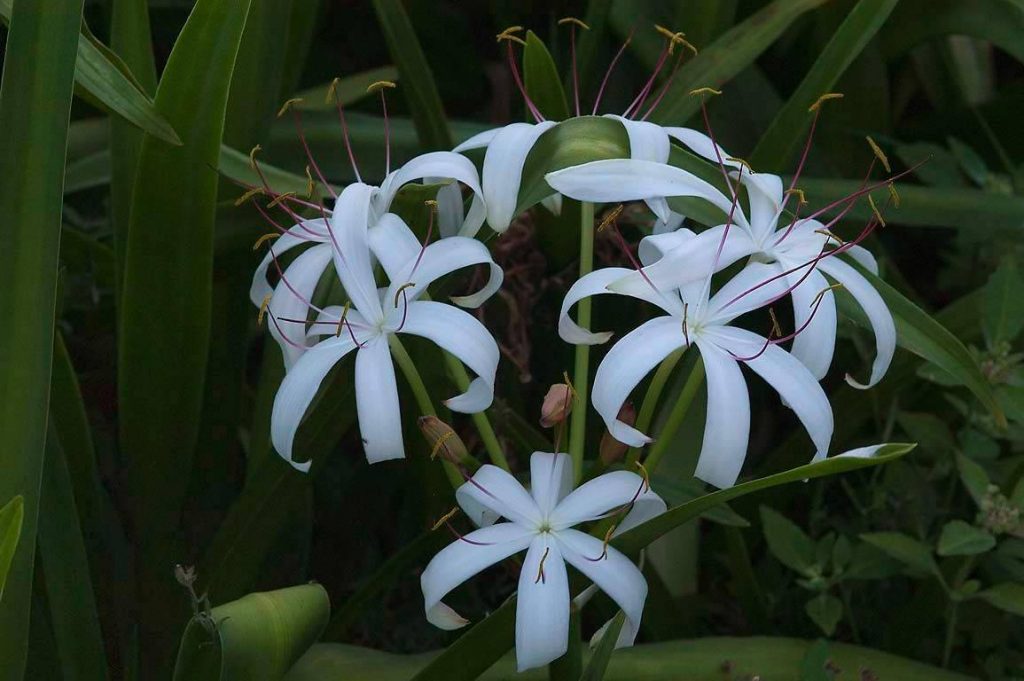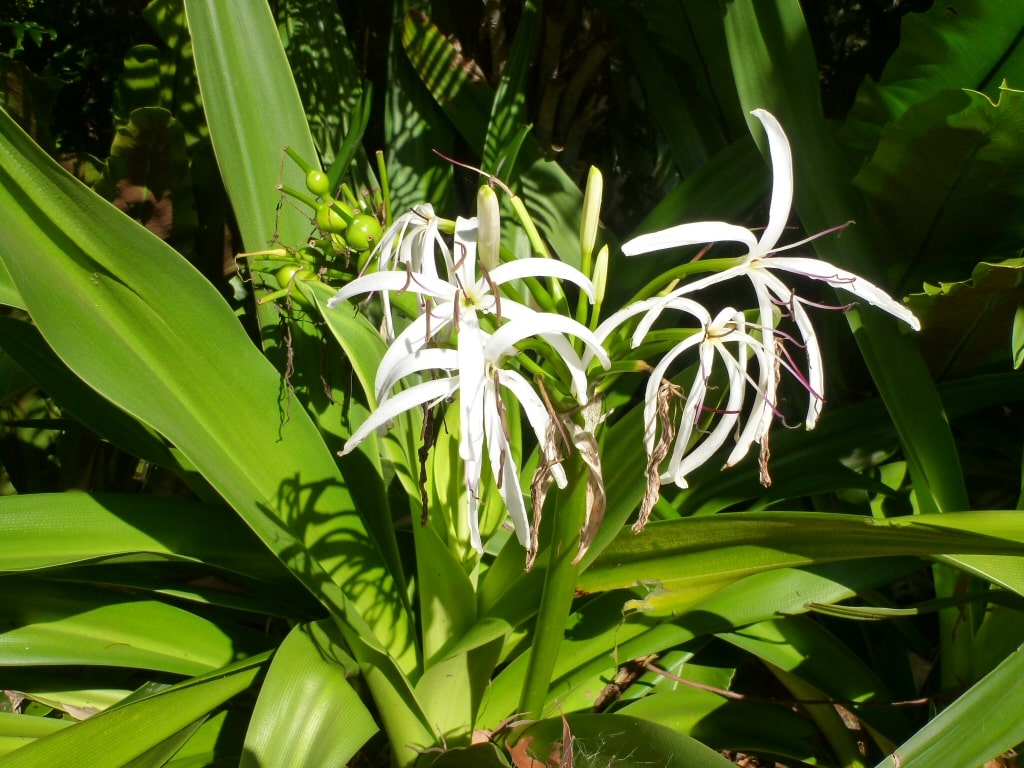Crinum lily is a plant belonging to the Amaryllis family, a genus of bulbs. Inhabitant of the tropics, subtropics.
There are varieties that have settled in the Cape region of South Africa. The name of the plant “Crinum” is translated from Latin as “hair”.
The comparison is bright, it accurately conveys the associative array that is called by the flower. The long xiphoid or even straight leaves of the Crinum lily resemble hanging strands of hair.
The Crinum lily has large bulbs in diameter – up to 25 cm, with a neck elongated to 90 cm. The leaves of some Crinum species reach a length of one and a half meters. When the leaves of the flower are young, they curl up into a tube, which helps to distinguish the plant from other Amaryllis.
The peduncle holds a voluminous umbrella inflorescence of either white or pink shades. The fruit is a seed pod. The seeds are large with a supply of water in the shell. The liquid in the seeds is enough for germination and the formation of a bulb of a young flower without external moisture.
Table of Contents
Planting Crinum Lily In Open Ground
Crinum lily is a moisture-loving tropical plant, it is also called a Crinum lily. Therefore, it will be necessary to provide it with a lot of light, moisture, and heat, but at the same time protect it from sudden gusts of wind.
Bulbs can be planted only when warm weather sets in and night temperatures do not fall below 10 ° C. The landing period is from the end of April to the end of May.
- An excellent solution would be to plant the bulbs in a pot in early March, followed by transshipment to a flower bed at the end of April: this way the plant will bloom a month earlier.
Let us recall on what lands the Crinum lily grows in natural conditions: we need soil rich in river silt (sapropel), saturated with sand.
Therefore, it is advisable to add more sapropel to the planting hole in half with sand and garden soil, then the Crinum lily will thank the gardener with luxurious flowers.
- In areas with mild winters, the Crinum lily can be left to winter in the ground, then the planting depth of the Crinum lily is as follows: the bulb is buried in such a way that a layer of soil of about 5 cm remains above it.
- If you dig, it is better not to bury the bulb, leaving it a third open. The distance between plants is 25-30 cm.
Crinum lilies grow in one place for about three to four years, after which a transplant is required with the separation of the resulting children.
Crinum Lily Care In The Open Field
Caring for a Crinum lily is not difficult: it is enough to free the flower bed from weeds, and periodically loosen the surface of the earth.
Be sure to water the plants every day using the right watering hose if the weather is dry and hot. In cloudy weather, watering is reduced.
During flowering, it is good to feed the Crinum lilies with a complex fertilizer for flowering. After the end of flowering, the flower stalks are cut off so as not to take strength from the bulbs and they were able to prepare for the dormant period (wintering).
The leaves will gradually die off, do not be alarmed: this is how the Crinum lily prepares for wintering. It is desirable to ensure the dryness of the soil at this time, creating a shelter from precipitation.
Crinum Lily Wintering
Wintering a Crinum lily is possible only with the vigilant care of the grower. In autumn, it is necessary to cover the bulbs with a thick layer of peat or replace the mulch with a straw up to half a meter thick (then it will settle).
In the spring, as soon as the frosts pass and the snow melts, the mulch is removed so that the bulbs wake up quickly and do not rot.
If you have frosty winters, it’s best to dig up the bulbs, lightly dry them in the shade, and store them in the refrigerator in the vegetable section.
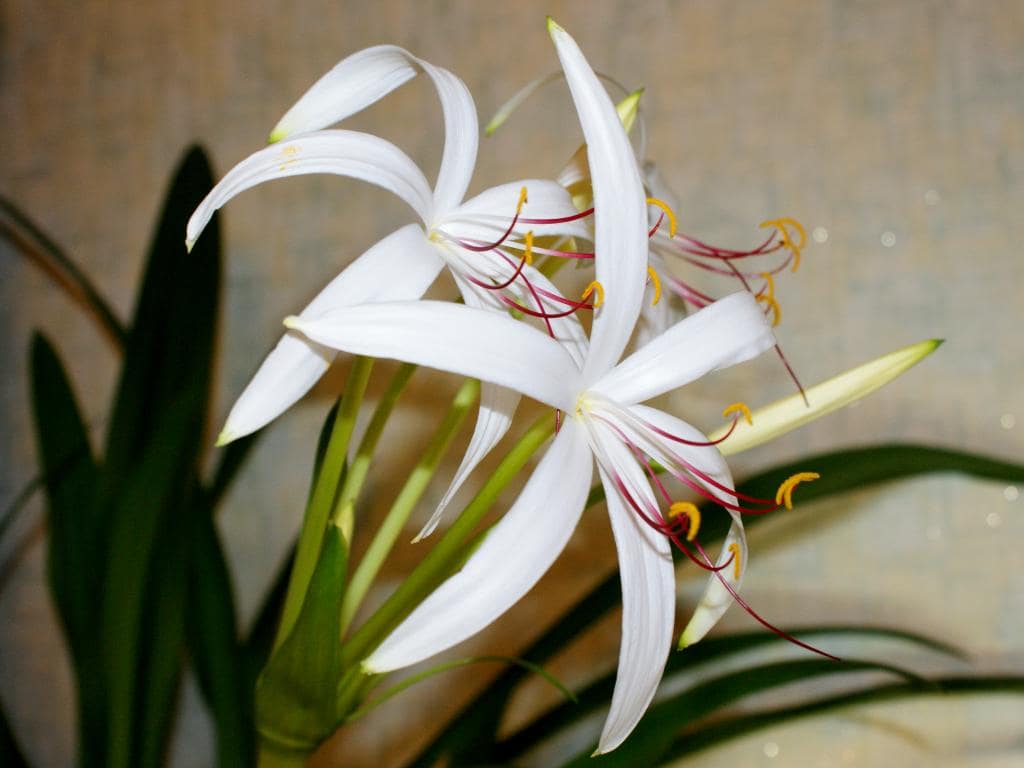
Crinum lilies can also be simply transplanted into pots and put in a dark, cool place, containing plants without watering.
Plants grown in containers are brought into cold rooms, where in winter the temperature will be about 5 ° C. With the threat of a decrease to zero, shelter with warm covering materials is mandatory.
By the way, some gardeners prefer not to take risks, because, after the flowering of the Crinum lily, the rainy season may well begin, which can provoke the rotting of the bulbs.
Therefore, the Crinum lilies are dug out, cut off, dried in the shade, and sent for storage in a cool, dry room (you can sprinkle the bulbs with dry sawdust and store them in boxes at +5 ° C).
Caring for Indoor Crinum Lily at Home
Lighting
Crinum lily loves the sun’s rays, strong, and bright without a shadow. The growth of plants directly depends on the intensity of consecration, the brighter, the faster the flowers gain strength. After a period of winter dormancy, the consecration cannot be sharply increased, otherwise, the Crinum lily will get sunburn.
South windows without shade correspond to the conditions for the successful cultivation of the plant. The leaves of the flower should be protected from contact with the glass on the windows to avoid burn injuries.
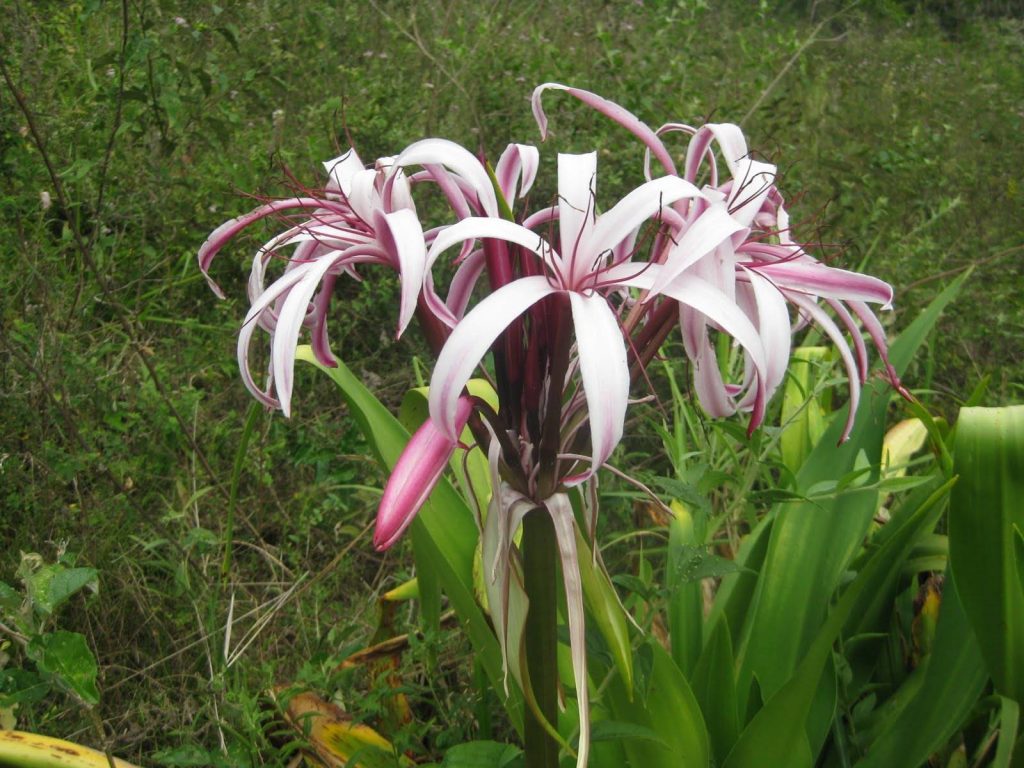
Outdoors in the summer, the Crinum lily feels great if protected from excess moisture. Plants living indoors are provided with an influx of fresh air with systematic ventilation and good ventilation.
In autumn and winter, intensive lighting, and fresh air are still the main conditions for the well-being of Crinum lilies. Wintering in low light leads to wilting of the lower leaves of the plant.
However, the flower never completely gets rid of the leaves, even during the dormant period young leaves grow. Artificial light fully satisfies the needs of the plant if the illumination lasts 16 hours a day.
Temperature
Crinum lilies are divided into South African and tropical groups. The South African group comes from the Cape region of South Africa with an arid climate. Place of cultivation – cold greenhouses in winter, in summer – open air.
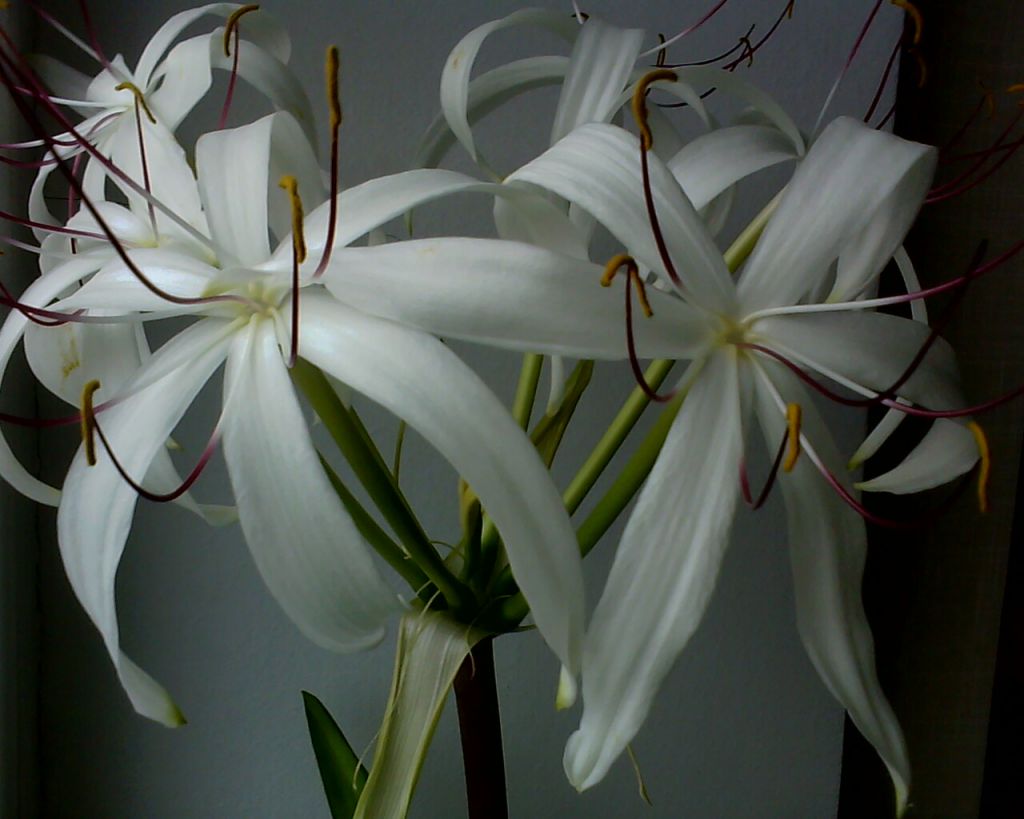
The subtropical zone allows the flower to overwinter without damage if a light coating is used. In spring and summer, the optimum temperature is 22-17 degrees. For a successful winter, 2-6 degrees is enough.
The tropical group is grown in warm greenhouses. The temperature of the summer months allows you to place the plants outdoors, choosing places protected from strong gusts of wind.
In spring and summer, the optimum temperature is 22-27 degrees. Without harm, the flowers will overwinter at a positive temperature mark of 14-18 degrees.
Air humidity. Crinum lily is insensitive to the level of atmospheric humidity. The leaves are systematically treated with a sponge soaked in water.
Irrigation Rules
The plant during the growing season needs watering with slightly warm water, drying of the upper layers of the soil should not be allowed. When the flowering period ends, watering is reduced, making sure that the soil remains moderately moist.
In winter, the time of rest comes for the Crinum lily, then the flower needs coolness and infrequent watering. The plant has bulbs with thick roots that perform their function all year round. Therefore, it is impossible to overdry the earth around the roots and completely stop watering.
Crinum lily bloom can be controlled. For winter flowering, the rest time is shifted to August-September, drying the soil without wilting the leaves.
Quite quickly, the plant throws out a peduncle, after which watering is returned to the previous level of intensity. To activate flowering, it is enough to stop moistening the soil for 7-14 days.
Top Dressing
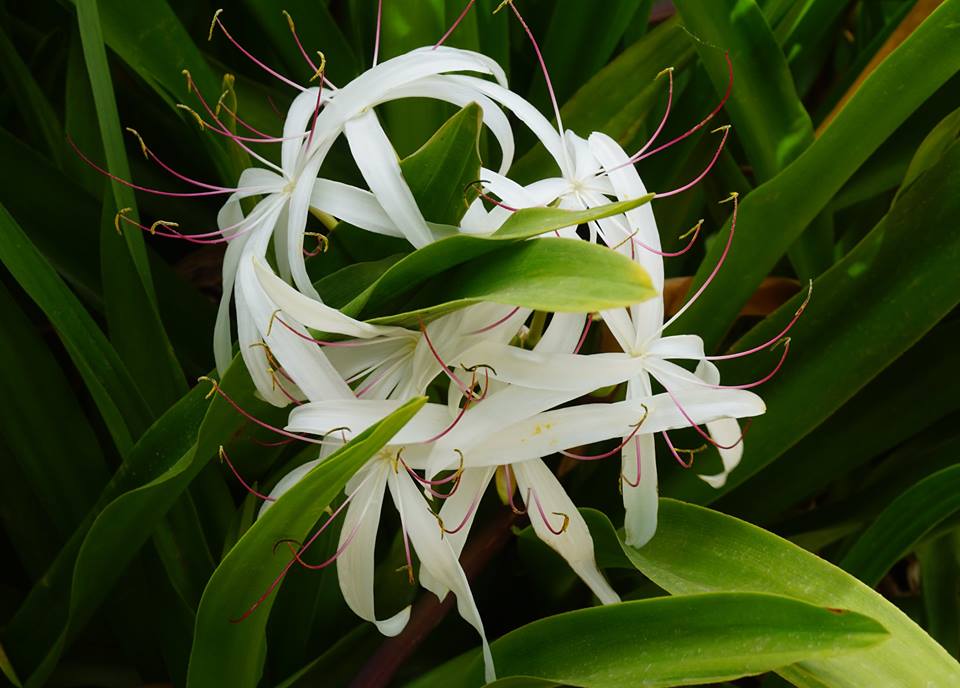
Crinum lily perfectly assimilates fertilizers designed for flowering houseplants. Liquid top dressing is applied once every 14 days. It is recommended to use the concentration indicated by the manufacturers. They start with the appearance of new leaves and end with the wilting of flowers.
Soil Mix for Crinum Lily in a Pot
The soil is prepared from soddy soil with an admixture of clay, leafy soil, peat, humus, and sand. Proportions 2:1:1:1:1. Charcoal, broken into pieces, will make the life of the plant more comfortable.
How to Transplant Indoor Crinum Lily in a Pot
- Transplantation of adult plants is carried out once every 3-4 years during dormancy.
- After planting, the onion should rise one-third above the soil.
- Crinum lily has impressive roots, because of this feature, the containers for transplantation must be deep.
- Remove dead, broken roots by carefully scraping the soil from healthy roots.
- A drainage layer of expanded clay is required.
- The distance from the bulb to the edges of the container is 3-4 cm.
Reproduction of Crinum Lily at Home
Reproduction by seeds is rare, it is much more convenient to divide by onion babies. Daughter bulbs activate the flowering of the parent, they are in no hurry with their separation. Babies bloom 2-4 years after separation, depending on size.
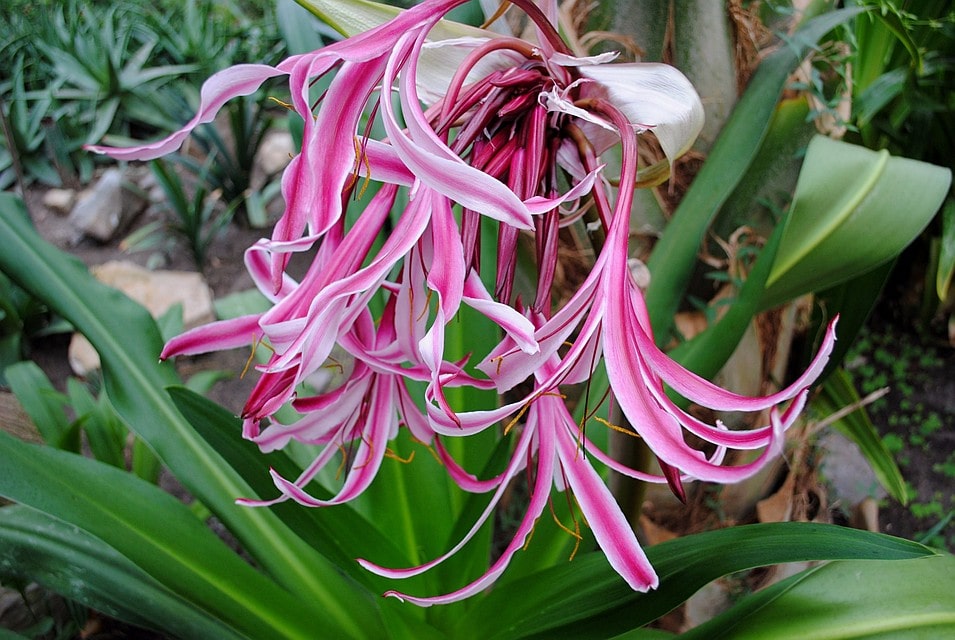
- First, the children are seated in pots with a diameter of 9-12 cm, after a year larger containers will be needed, after another year 16-17 cm pots are needed.
- Regular top dressing and abundant watering are necessary during the growth of young Crinum lilys.
- Large deep pots up to 28 cm in diameter create favorable conditions for Crinum lilies in the 3rd-4th year of life. Spacious containers stimulate the formation of children, lush flowering, and rapid growth.
Pests and Diseases
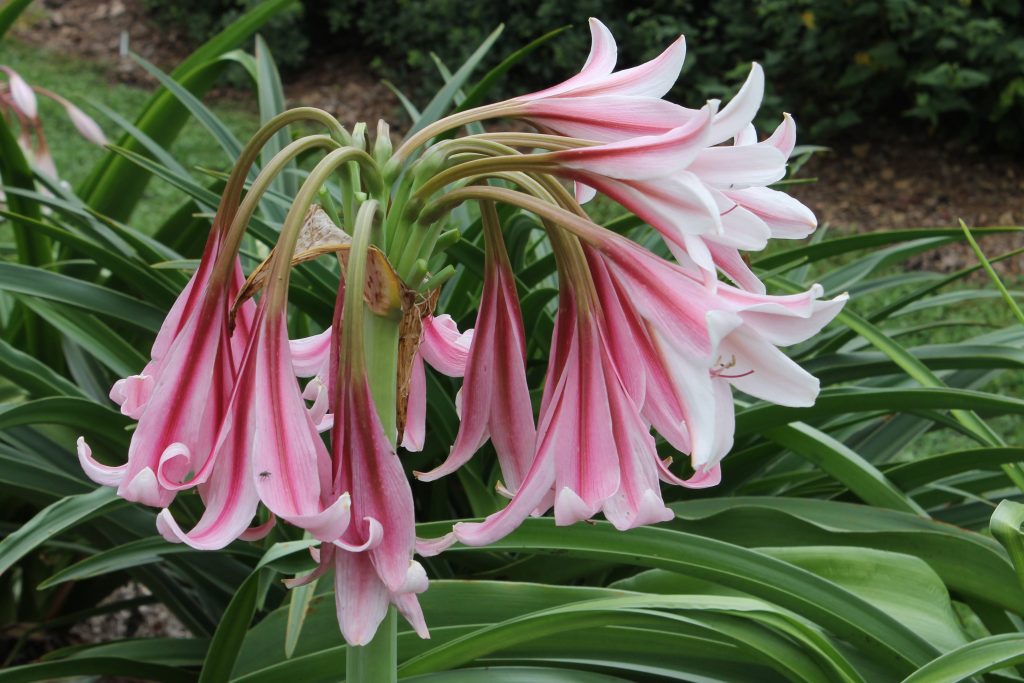
The main threat to plants is an excess of moisture. Waterlogging leads to the rotting of the root system. Crinum lily is affected by a spider mite, causing serious damage to the flower. Mealybug loves to settle in the leaf axils.
Among plants growing along the banks of water bodies, the Crinum lily enjoys well-deserved popularity among landscape designers.
The flower is hardy, exotically beautiful, and unpretentious. Crinum lily can be grown by both experienced greenhouse growers and novice gardeners.




